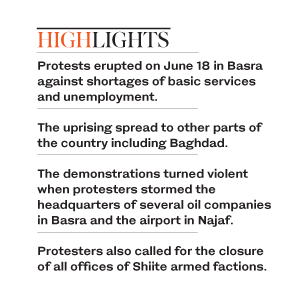BAGHDAD: For nearly 15 years, Shiite armed factions backed by Iran have imposed a reign of fear in southern Iraq.
They fought US-led troops after the 2003 invasion, played a leading role in the sectarian war that engulfed the country between 2006 and 2008, and were the backbone of the forces that defeated Daesh after the militants seized almost a third of Iraq in 2014.
The Shiite militias’ brutality, the boldness of their fighters and their blatant defiance of the Iraqi authorities meant that no one dared challenge their rule. They have significant influence in Baghdad and the south, and continue to challenge the Iraqi government on a daily basis. Clear red lines were drawn around them, and anyone who publicly crossed those lines risked being killed.
Their rule was absolute — until now. Massive demonstrations that have swept southern Iraqi provinces for the past two weeks were angry protests against shortages of basic services such as electricity and water, and high rates of unemployment and poverty. But they have also shattered the self-assured arrogance of the pro-Iranian Shiite armed factions and challenged their influence, observers and Iraqi security officials have told Arab News.
Protesters attacked the headquarters of several militant groups, including the most powerful Shiite paramilitaries, the Badr Organization and Asaib Ahl Al-Haq. At least four people were shot dead as they tried to storm the organizations’ offices in Najaf, Diwaniya and Muthanna and set them on fire.
The protests may be the first step toward removing them from the equation, thus limiting Iranian influence in Iraq by clipping the wings of the pro-Iranian political parties that use the groups as tools to strike at rivals and opponents.
“What happened in these demonstrations has really broken the prestige of these groups,” a senior Iraqi national security official told Arab News. “It sent a strong social message that says there are no red lines anymore and this situation (the dominance of armed factions on the Iraqi streets) will not last for much longer.
“This was a significant shift in the Iraqi public perception. People have come to know where to direct their anger and who they have to face.”
The first protesters took to the streets on July 18 in the southern oil-hub city of Basra to protest against a serious lack of electricity, a shortage of drinking water and the high rates of poverty and unemployment. This was followed by uprisings in Shiite-dominated southern provinces such as Dhi Qar, Muthanna, Amara, Karbala, Babil, Najaf, before the protests spread to the capital, Baghdad.
The mass demonstrations turned violent when protesters stormed the headquarters of several oil companies in Basra and the airport in Najaf, set fire to government buildings and tried to swarm the offices of the pro-Iranian Shiite political parties and paramilitary groups.
Iraqi security forces, which have been on high alert since the protests began, and guards at the offices opened fire to disperse the protesters. Fourteen people were killed and hundreds wounded, most of them members of the security forces.
Protesters in impoverished Amara, southwest of Baghdad, demanded the closure of all offices of Shiite armed factions and the surrender of their weapons to the state as part of their conditions to end their demonstrations.
“Regardless of the identity of the demonstrators who attacked these offices or presented their demands, the barrier of horror that surrounds these groups has been broken,” said Mustafa Sa’adoun, an Iraqi analyst. “The demonstrators just told the tough guys, ‘Your day is coming and you are reachable’.”
Despite efforts by Iraqi Prime Minister Haider Abadi to ease tensions by increasing the hours of electricity generation and water flow, and announcing thousands of new jobs, demonstrations are expected to continue growing in Baghdad and the south.
Iraqi politicians have yet to ratify the results of the parliamentary elections held in May and form a new government.
The country has been a battleground for many international and regional powers, particularly the US and Iran, since the 2003 US-led military invasion. No new government will be formed without the approval of Washington and Tehran. 
Several security sources suggested that followers of the influential Shiite cleric Muqtada Al-Sadr, whose Sairoon Alliance took first place in the preliminary results of the May elections, were involved in the protests and attacks on the offices of Asaib, Badr and other groups. However, other intelligence information indicates the involvement of other local and international interests in the unrest.
“The demonstrations have provided great cover for the regional and international powers operating in Iraq to terminate their opponents in an attempt to expand their areas of influence,” said a senior intelligence official.
“The results of the elections did not satisfy many in the region, and the world, so they have been trying to influence the political forces and push them in certain directions to form the next government.
“It is a big game — much bigger than us.”
The rivalries between regional and international powers and their proxies in Iraq, along with a desire to dominate the Iraqi streets to affect the chances of Abadi serving a second term as prime minister, increase the chances of further attacks on the offices of Shiite groups and their armed factions.
“Our intelligence information suggests that the demonstrations are still growing and have not reached a peak yet,” the intelligence official said. “It is not clear yet when and where the peak of demonstrations will take place, but the pressure on the Iraqi government will be much greater than what we have witnessed so far.”

























